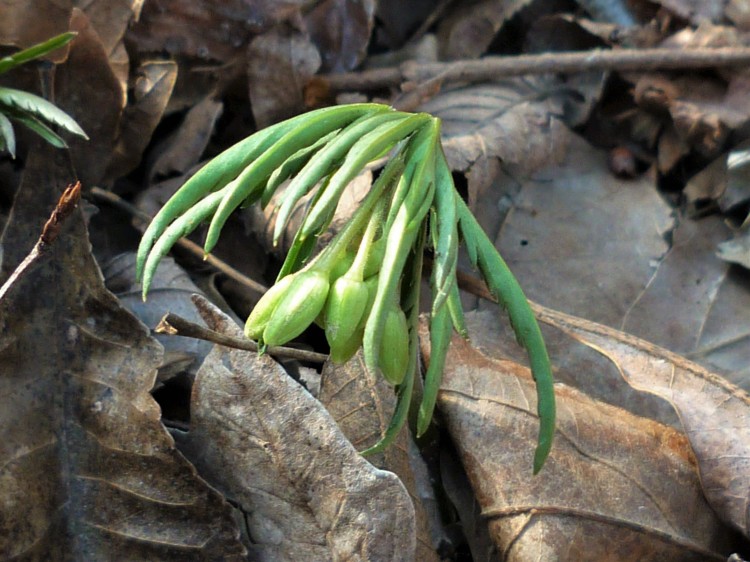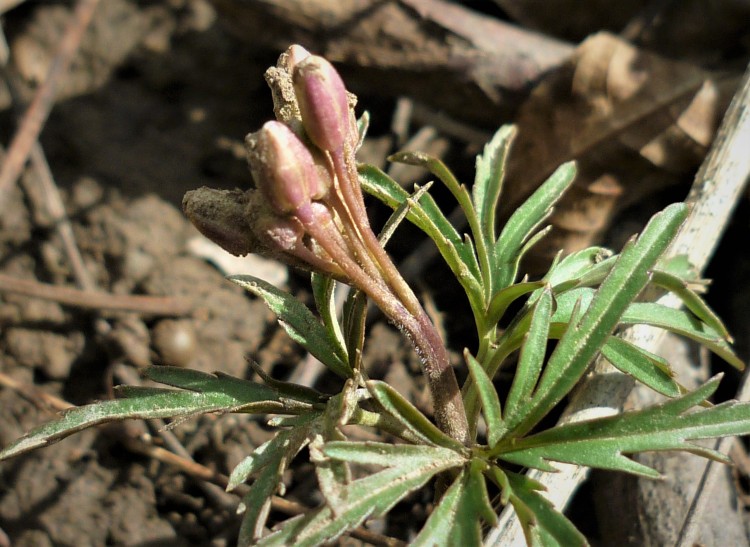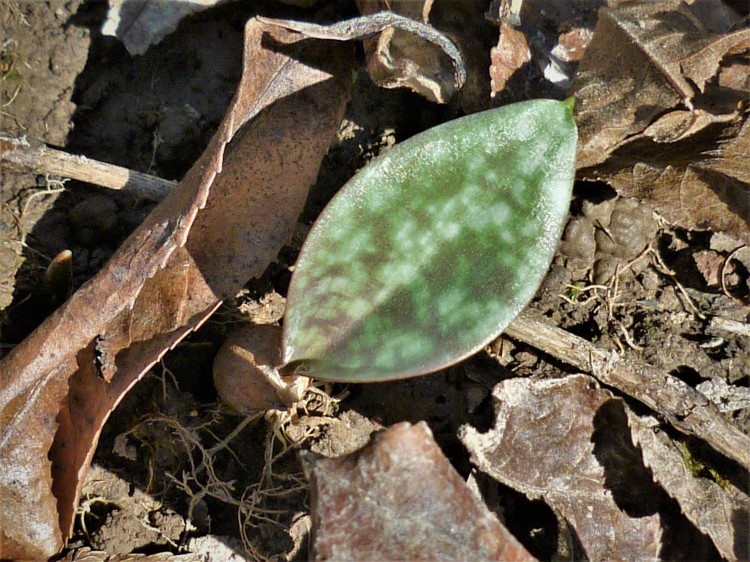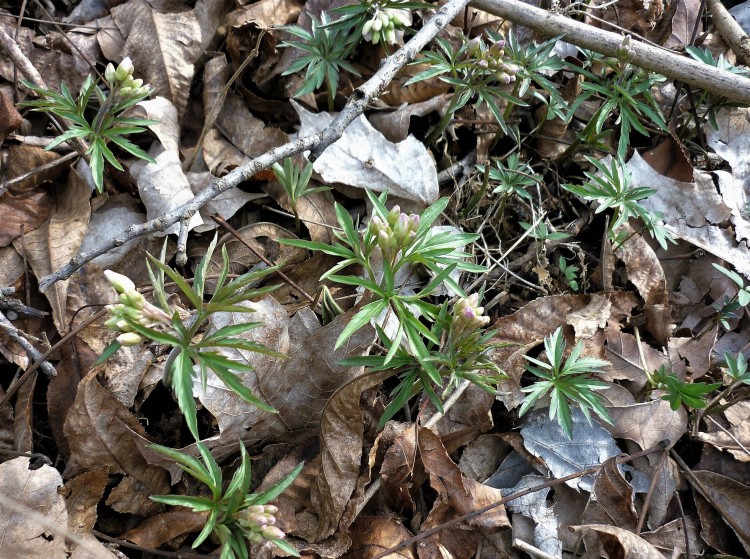
Fleshy leaves sheltering a cluster of flower buds – Cut-leaved Toothwort, Cardamine concatenata, has already emerged on 3/5. “Spring Ephemeral” is not the best term for these hardy little early bloomers. Though their flowers are brief, they’re very long-lived. As the first to come up from the warming soil, they’re also well-adapted to any radical swings of temperature March may offer up. But early spring has its advantages, mainly a sunny leaf-free understory (when the sun is even out). Spring ephemerals are not “shade plants” when they’re blooming.
Going dormant early, they survive by storing energy in corms and rhizomes for most of the year. Their long absence definitely makes my heart grow fonder.

Though it’s the commonest of wildflowers in eastern hardwood forests, Cut-leaved Toothwort is not common in this degraded urban fragment. A site like the one in the pic above is quite unique, with a nice cover of fallen leaves and no evidence of Wintercreeper, Bush Honeysuckle or Privet. This didn’t just happen to be so – invasive plants were removed intensively from the site as it became evident there was a small relict population of ephemerals – Toothwort, Trout lily, and Mayapple. These three species are the most abundant of the handful of spring ephemerals that remain here.
As one of the richest sites in this forest, it’s been attended to for a number of years, and the resulting rebound of ephemerals has been good to see. But this site will continue to need a yearly “maintenance pulling” of invasive plants. The problem with Bush honeysuckle invading spring ephemeral sites – it leafs out very early, adding unwelcome shade when the native flowers need full sun. So I will go through and parse it over each season. If it seems obsessive to concern oneself with such a tiny area, I just consider it my meditation and much more rewarding than yard work.

Where ephemerals are still found in this forest tells a lot about former land use. While some species (the ones remaining here) can withstand a certain amount of grazing and disturbance, chronic alteration of the landscape spells their doom. The remaining sites in this forest are all on relatively low moist slopes, and were likely very wildflower-rich and diverse back in the day. Perhaps this helps explain their persistence – most ephemerals are found in very long-lived colonies and can’t just regrow where they’ve been lost. It literally takes hundreds of years for large colonies to form.

Add to these impacts, the more recent ravages of stormwater scouring, competition with heavy wintercreeper groundcover, and shade from taller invasive plants.

Amid the Toothwort, the tiny pointed leaf tips of Trout lily Erythronium americanum are now poking up.

In contrast to Toothwort’s rhizome, Trout lily grows from a corm. It is indeed a member of the Liliaceae or Lily family, and spreads very slowly, mostly asexually, by producing smaller corms and “droppers” (stems that branch off from the parent corm).

As of yesterday, the Toothwort had raised itself higher above the leaf litter and was close to blooming. This morning it’s covered with snow. Such is life for spring ephemerals.
Even if you’re itching for spring to happen, don’t discount today…
“It is essential to experience all the times and moods of one good place”
– Thomas Merton, Conjectures of a Guilty Bystander
Marianna metcalf
You make me see and understand so many new things. Thank you.
LikeLiked by 1 person
oneforestfragment
Thank-you Mariana! Writing this blog makes me pay attention more too.
LikeLike
j3w3lw33d
No doubt you replanted that little guy back in the dirt! I read somewhere that Troutlilly can actually hold the soil together on a hillside or even a streambank when it is in a dense colony. Sadly the Troutlilly down here in south Georgia is all done blooming. I will get to see it again when I go back up to Philly though.
LikeLiked by 1 person
oneforestfragment
Yes you guessed it, I didn’t leave the poor thing stranded! Lacking those dense colonies of spring ephemeral corms and rhizomes definitely makes the soils in this forest more vulnerable. The invasive vine Wintercreeper often steps into that role, however by completely taking over the forest floor.
The TroutLlily preserve looks like a real gem, so great the community values it.
LikeLike
j3w3lw33d
Wolf Creek Trout Lily Preserve is certainly a gem! I am hoping to have time to volunteer there removing invasives. Your approach to remove the invasives from the most unaltered areas of your site is The way to go. From a prioritization point of view you want to preserve the best preserved first! No point in having a localized extinction. The mayapples and trout lilies and other spring ephemerals May be genetically distinct from ones in other areas and to lose that specific patch would be a shame. When you clear other areas nearby of invasives maybe you could use some of the seeds of your original plants in those spots since they are the most adapted to that area.
LikeLiked by 1 person
oneforestfragment
Good point! Although admittedly if we get funding somewhere I want to look at replacing some propagated ephemerals, not necessarily local genotype but N. Tennessee nursery grown. Some that are scarce to non-existent in this fragment, such as Mertensia, Wild Ginger, Bloodroot, etc. are also rumored to be relatively unpalatable to deer. I’m of the opinion that some new blood might be a good thing too, considering that these relicts are likely not very genetically diverse anymore.
LikeLiked by 1 person
debbie utz
I enjoy seeing these as I walk at BCSNP. What I consider true signs of spring!
LikeLike
oneforestfragment
Watch for them especially past #19, where the trail turns sharply to the left. I have sprayed Wintercreeper there, and was hand pulling today – looks like a lot more Toothwort emerging than in previous years!
LikeLike